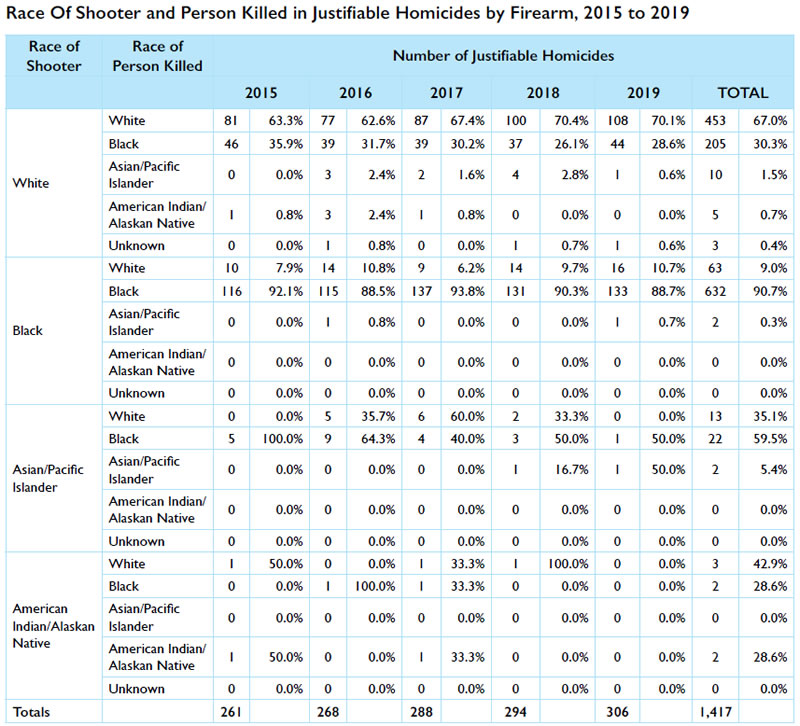Guns are Rarely Used by Asian Americans in Justifiable Homicides
Despite the firearms industry and gun lobby’s rhetoric and advertising, firearms are rarely used in justifiable homicides by private citizens. In 2019, across the U.S., Asian/Pacific Islanders committed two firearm justifiable homicides. For the five-year period 2015 to 2019, Asian/Pacific Islanders committed 37 firearm justifiable homicides. During this same five-year period, 3,076 Asian/Pacific Islanders lost their lives in firearm homicides, suicides, fatal unintentional shootings, and other firearm deaths: a ratio of 83 to one.

While it is clear that guns are rarely used to justifiably kill criminals, an obvious question remains: How often are guns used in self-defense whether or not a criminal is killed? The answer comes from the Bureau of Justice Statistics’ National Crime Victimization Survey (NCVS).30
According to the NCVS, which has been ongoing since 1973, looking at the total number of self-protective behaviors undertaken by victims (of all races and ethnicities, Asian-specific data is not available) of both attempted and completed violent crime for the three-year period 2014 through 2016, in only 1.1 percent of these instances had the intended victim in resistance to a criminal “threatened or attacked with a firearm.”31 For the three-year period 2014 through 2016, the NCVS estimates that there were 16,115,500 victims of attempted or completed violent crime. During this same three-year period, only 177,300 of the self-protective behaviors involved a firearm. Of this number, it is not known what type of firearm was used or whether it was fired or not. The number may also include off-duty law enforcement officers who use their firearms in self-defense.
According to the NCVS, looking at the total number of self-protective behaviors undertaken by victims of attempted or completed property crime for the three-year period 2014 through 2016, in only 0.3 percent of these instances had the intended victim in resistance to a criminal threatened or attacked with a firearm.32 For the three-year period 2014 through 2016, the NCVS estimates that there were 45,816,900 victims of attempted or completed property crime. During this same three-year period, only 123,800 of the self-protective behaviors involved a firearm. Of this number, it is not known what type of firearm was used, whether it was fired or not, or whether the use of a gun would even be a legal response to the property crime. And as before, the number may also include off-duty law enforcement officers.
Back to Table of Contents
Next – Conclusion
30 According to the website of the Bureau of Justice Statistics, the “National Crime Victimization Survey (NCVS) is the nation’s primary source of information on criminal victimization. Each year, data are obtained from a nationally representative sample of about 240,000 interviews on criminal victimization, involving 160,000 unique persons in about 95,000 households. Persons are interviewed on the frequency, characteristics, and consequences of criminal victimization in the United States. The NCVS collects information on nonfatal personal crimes (i.e., rape or sexual assault, robbery, aggravated and simple assault, and personal larceny) and household property crimes (i.e., burglary/trespassing, motor-vehicle theft, and other theft) both reported and not reported to police. Survey respondents provide information about themselves (e.g., age, sex, race and Hispanic origin, marital status, education level, and income) and whether they experienced a victimization. For each victimization incident, the NCVS collects information about the offender (e.g., age, race and Hispanic origin, sex, and victim-offender relationship), characteristics of the crime (e.g., time and place of occurrence, use of weapons, nature of injury, and economic consequences), whether the crime was reported to police, reasons the crime was or was not reported, and victim experiences with the criminal justice system.” (See Bureau of Justice Statistics, “Data Collection: National Crime Victimization Survey (NCVS),” http://www.bjs.gov/index.cfm?ty=dcdetail&iid=245.)
31 For “violent crime” the NCVS measures rape or sexual assault, robbery, and aggravated and simple assault.
32 For “property crime” the NCVS measures household burglary/trespassing, motor vehicle theft, as well as property theft. Since the survey information is obtained from a sample of households, it does not include property crimes affecting businesses or other commercial establishments. If such crimes are reported to law enforcement, they are included in the FBI’s Uniform Crime Reporting Program. The NCVS includes property crimes affecting victims and household members which were reported and not reported to the police.






